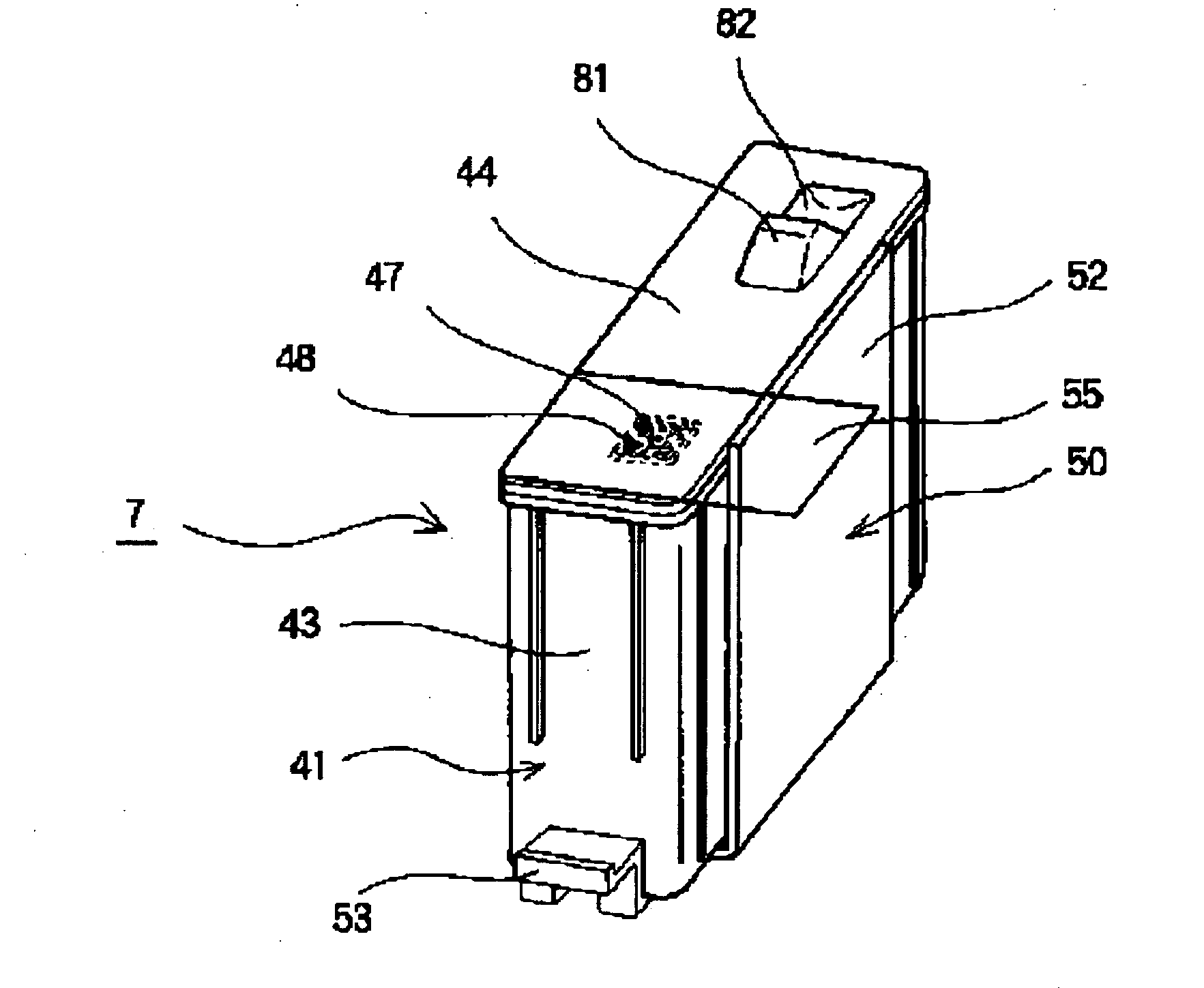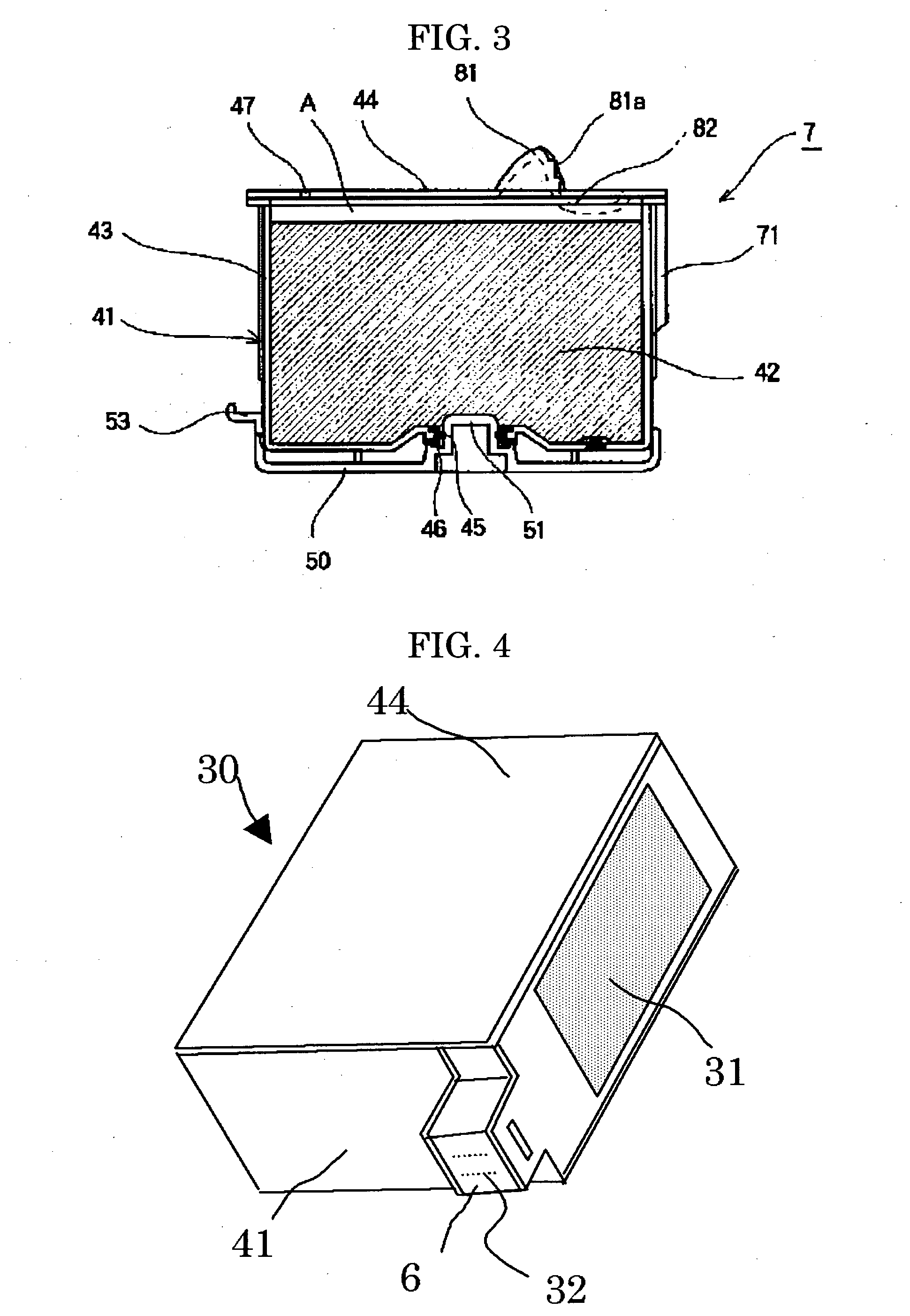However, it is very difficult to satisfy all necessary properties including color reproducibility of images,
wear resistance, light resistance, gas resistance,
water resistance,
drying property of images, character spreading (
feathering), spreading at color boundary (color bleed), concentration nonuniformity at
solid portion (beading), printing ability on both sides, and ejection stability, thus an ink composition and a recording medium are selected depending on prior properties of individual applications.
However, dyes suffer from
poor quality non-allowable on regular paper due to inferior light resistance, gas resistance, and
water resistance.
In order to address this problem, inkjet-exclusive recording paper having an ink absorbing layer has been used and challenged to improve theses resistances, but there still is a problem that the quality is insufficient.
However, the pigments suffer from inferior coloring property compared to dyes.
The reason is believed that lights with different wavelengths and phases interfere in the pigments due to optical multiple reflections.
Therefore, there arise such problems as decrease of
color saturation in regular paper and decrease of gloss level in inkjet recording paper when the pigments are employed for a colorant of an ink composition for inkjet recording.
The regular paper having such high water absorbability is advantageous because of being thin and inexpensive, however, suffers from images with poor coloring property and gloom impression since coloring ingredients of ink compositions easily infiltrate into the paper and thus the amount of coloring ingredients on the surface comes to small.
The absorbability of the inkjet-exclusive recording paper can be afforded by way of providing a layer of inorganic
pigment or water-absorbable
polymer on the surface, thus coloring ingredients can remain around the surface and highly coloring property can be induced; however, the inkjet-exclusive recording paper suffers from larger thickness and higher cost beyond comparison with that of the regular paper.
The
polymer films as the
recording media can scarcely absorb water, thus there often arise such problems as offset smear and ink-void due to spurs (hereinafter sometimes referred to as “spur
stain”), beading, and backside smear while stacking, thus the polymer films are far from practical use.
However, when the colorant is an aqueous dye, there arises such a problem that the resulting color is of
low density and dull since the colorant migrates into substrates (
cellulose) through pores of
coating layers at the surface together with
moisture and aqueous
solvent without remaining on the surface.
Furthermore, when
pigment inks are employed, highly coloring images can be obtained, however, there arise such problems as spur
stain, beading, and backside smear while stacking because of slow
drying of ink compositions.
However, this proposal suffers from such problems as dangerous handling, tendency to decrease significantly fixability of acid-free paper, easy show through, and remarkable difficulty to
record both sides.
However, this proposal is limited to industrial applications in
spite of excellent fixability since countermeasures for
odor and safety as regards the
organic solvent are essential, thus is far from the situation to be employed in offices and general homes.
The ink composition of this proposal may exhibit an excellent drying velocity after printing compared to those of conventional ink compositions, however, hands may be stained upon taking promptly by hand the matters printed at recording apparatuses depending on the species of papers, or significant
feathering may occur depending on the species of papers.
However, this proposal leads to convex portions of printed characters, which arises such problems as the printed characters transfer and / or papers stick together when a number of the printed matters are stacked and left to stand.
In addition, a heating unit is necessary to heat the ink composition, which making the apparatus complicated.
However, this proposal suffers from larger
electricity consumption since heating rollers and warm-air blowers are necessary, which making difficult to be used in offices or general homes.
As described above, colorants on the basis of dyes exhibit excellent coloring property compared to colorants on the basis of pigments, but represent non-allowable quality when combined with regular paper because the light resistance, gas resistance, and water resistance are inferior as described above.
However, these proposals are limited to recording on regular paper or inkjet-exclusive recording paper, and there arise such problems as occurrences of beading and insufficient drying property when being recorded on
recording media with a lower absorbability, specifically, on those of which the amount of pure water transferred to the recording media is below 4 ml / m2 at a contact period of 100 ms and below 5 ml / m2 at a contact period of 400 ms.
This proposal may be effective for recording paper with higher absorbability since higher
viscosity leads to higher
solid content of ink compositions as well as more prompt drying, but is insufficient for recording media with lower absorbability.
The regular paper with such adequate absorbability is advantageously thin and inexpensive, however, there arise such problems as show through occurs since color ingredients of inks tend to infiltrate into paper and the coloring property is poor and the images induce gloom impression since the amount of coloring ingredients on the surface comes to small.
On the other hand, the exclusive recording paper is provided with the absorbability by way of placing a layer of inorganic pigment or water-absorbable polymer on the surface, thus coloring ingredients can remain around the surface and highly coloring property can be induced; however, the inkjet-exclusive recording paper suffers from larger thickness and higher cost beyond comparison with that of the regular paper.
The polymer films as the recording media can scarcely absorb inks, thus there often arise such problems as offset smear and ink-void due to spurs, beading, and backside smear while stacking, thus the polymer films are far from practical use.
There arise in these recording media such problems as occurrences of spur
stain, beading, and backside smear while stacking since the drying of inks is slow in these recording media.
When images are formed on these recording media using aqueous inkjet inks, there arise such problems as heavy bleeding and show through, lower density, and gloom coloring, since the colorant under a dissolved condition like water-soluble dyes migrates into substrates (
cellulose) through pores of
coating layers at the surface together with
moisture and aqueous
solvent without remaining on the surface.
When the colorant represents a dispersed condition like pigments, the coloring property may be excellent compared to those of water-soluble dyes since the colorant remains on the surface; however, the poor coloring property cannot be improved inherently to pigments, resulting in images with unsatisfactory coloring property.
However, the water-insoluble dye may dissolve into an
organic solvent in inks thus the water-insoluble dye partially dissolves into an ink vehicle, and the dye under a dissolved condition causes coloring of clear color inherent to the dye.
Therefore, there arise such problems as occurrences of bleeding and show through,
low density, and gloom coloring similarly as water-soluble dyes when the dissolved content of dyes is excessive.
As regards the process to solve the problems in terms of the drying property described above, a recording process is proposed to use an oil-based ink composition containing a water-insoluble
organic solvent as a
liquid medium; however, this proposal is limited to industrial applications in
spite of excellent fixability since countermeasures for
odor and safety as regards the organic solvent are essential, thus is far from the situation to be employed in offices and general homes.
These proposals make possible to take the water resistance and the gas resistance equivalent with those of pigments, however, their applications are limited to recording on the regular paper and the inkjet-exclusive recording paper, and do not address the problems such as beading and drying property where recording is carried out on recording media with lower absorbability like the present invention.
 Login to View More
Login to View More 


